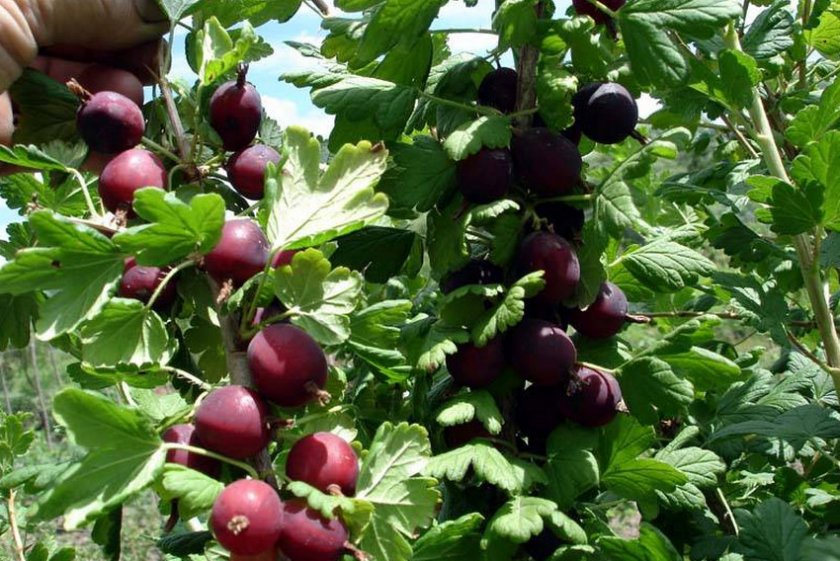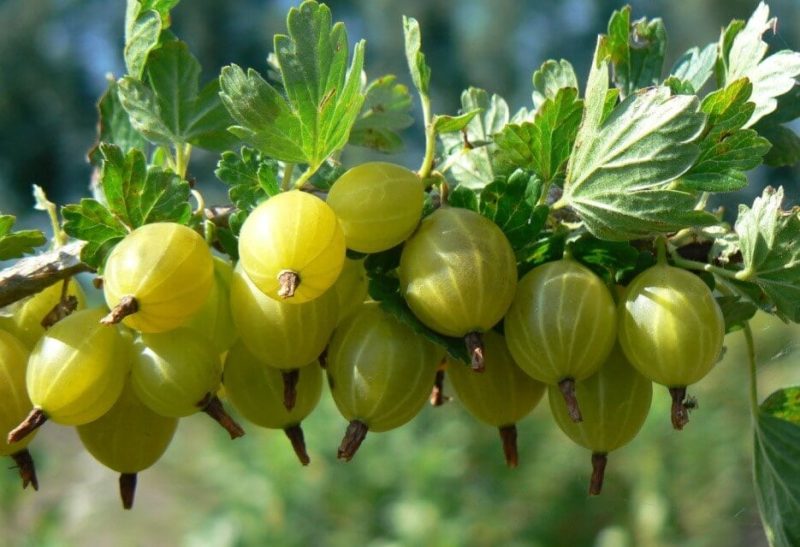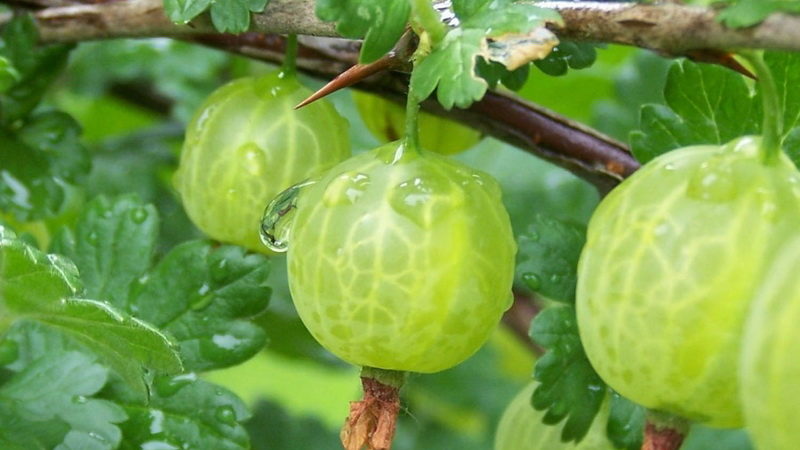Gooseberry varieties from Belarusian breeders: "Ravol", "Coral" and others
Gardeners most often choose gooseberries for planting on the site, which are unpretentious in care, hardy to weather conditions and gives tasty berries. All these criteria are met by the varieties bred by Belarusian breeders - Ravolt, Coral and Belorussky Sugar. We will tell you about their features, which regions they are suitable for and how to grow them.
The content of the article
Gooseberry varieties, zoned in Belarus
Belarus is located in a temperate climatic region. Its features are mild winters, cool summers and arctic winds. In such conditions, gooseberry varieties Ravolt, Korall, Belorussky Sugarny are successfully developing.
Important! All three varieties are resistant to powdery mildew and anthracnose.
Features of plants:
- Gooseberry Rawolt - frost-resistant medium late variety, bearing fruit at the end of July. Thorns are light, rare, single, small in size, perpendicular to the trunk. Yield high - up to 10 t / ha.

- Coral variety - frost-resistant early-ripening gooseberry, bearing fruit in early June. Has long double and triple pimples. Ultra-high yield - 14 t / ha.

- Sort Belarusian sugar belongs to the medium early, bears fruit from late June to early July, frost-resistant. Produces crops for 12-18 years. Differs in a large number of thorns, brown color.

History of origin and distribution
Breeders from Belarus under the leadership of A. Dmitrieva on the basis of the Institute of Fruit Growing of the National Academy of Sciences tried to develop gooseberry varieties that would be distinguished by resistance to severe frosts (up to -30 ° C), powdery mildew, and sudden changes in temperature.
When crossing the gooseberry varieties Black Negus and Yarovaya by free pollination, the Ravolt variety was obtained, which inherited all their qualities.
The institute staff continued the experiment and crossed Ravolt and Yarovaya. The result is Coral gooseberry.
The sweet gooseberry Belarusian sugar was bred by crossing the varieties White Large and Belorussky.
On a note! In 2007, Korall gooseberries, and in 2009 Ravolt gooseberries were included in the Unified Register of Varieties of the Republic of Belarus.
Characteristics and description of the bushes
- The height of the Belarusian sugar bush is up to 1-1.5 m. The branches are long, straight, slightly spreading, from the weight of the berries they lean to the ground. The yield from one bush is 3.5-6 kg. Leaves with a grayish-green tint, large.
- Ravolt grows into a medium spreading bush up to 0.8-1 m high... The branches form a spherical crown. Basal shoots do not lean to the ground, but stretch upward. Green leaves, rough on the back. It begins to bloom in May.
- Coral grows into a compact bush up to 1 m high. The basal stems are strongly spiked with thick needles.
Reference. In gardening, bushes are used to plant decorative hedges.
Resistant to temperatures
All three varieties of gooseberries are frost-resistant. Withstand lowering the temperature to -30 ° C.
Moisture and drought resistance
The bushes tolerate dry weather for up to 3-4 weeks.During the flowering period and the ovary of the fruits, they need abundant watering once a week. Swampy areas and high humidity inhibit the growth of the bush.
Disease and pest resistance
At the beginning of the 20th century, most of the gooseberry bushes were destroyed by powdery mildew. The varieties Ravolt, Coral and Belorussky Sugarny have a high resistance to this disease, as well as to anthracnose. Pests (aphids, mites) are not dangerous for plants if preventive measures are taken.
Characteristics and description of fruits
- Description of Ravolt gooseberry fruit: berries are round, with a dark red color, weighing 3.4-4.4 g. Taste sweet and sour. In a brush 1-2 pcs.
- Coral variety: fruits are round-oval, with a white wax bloom, yellow, weighing no more than 3 g. Collected 1-2 pcs. The pulp is juicy inside, the skin is thin.
- At the Belarusian sugar large fruits weighing 9-10 g, light green color. The skin is smooth, thin, but strong, which allows them to be transported without mechanical damage. The taste is sweet, dessert. They are consumed fresh.
Areas of use
Gooseberries are used in cooking, fresh and frozen, for making jam, jam, compotes, salad, fruit cocktails, baked goods.
In medicine, gooseberry berries are recommended in violation of metabolic processes in the body, as a diuretic and choleretic agent.
Advantages and disadvantages compared to other varieties and hybrids
Benefits of Belarusian gooseberry varieties:
- unpretentious care;
- frost resistance;
- resistance to powdery mildew, anthracnose;
- transportability of fresh berries;
- self-pollination.
The disadvantages of gardeners include the presence of thorns, which complicate the process of caring for the bush, pruning it and harvesting.
Growing technology
Successful cultivation does not require much effort, since these gooseberry varieties are unpretentious in care.
Optimal conditions
Suitable for cultivation are black soil, loamy, sandy loam soil. Gooseberries grow poorly in dark places, without sunlight, with a close occurrence of groundwater (up to 1.5-2 m). He does not like drafts and the north wind.
Terms and rules of landing
Gooseberries are planted in the fall, a month before the onset of the predicted frost. In cold regions, planting in spring is not recommended, since the period between warming up the soil and swelling of the buds is very short.
How to plant:
- Dig a hole 50 cm in diameter and 60 cm deep.
- A mixture of deciduous compost and chernozem, 200 g of superphosphate, 30 g of potassium fertilizer are poured into the pit at the bottom.
- Pour in 2-3 buckets of water and wait for it to be absorbed.
- A gooseberry seedling is planted in the center, placing the root collar 5-7 cm above the soil surface, straighten the roots and cover with earth.
Further care
To obtain a healthy harvest, the rules for caring for the bush are observed:
- Water the gooseberry once every 7-10 days.
- The plant is fed once a year. To do this, use chicken or cow manure (0.5 liters of infusion per 10 liters of water), wood ash, deciduous compost, mineral fertilizers.
- Loosens the soil so that more air flows to the roots and does not form a crust on the soil.
- Prune the bush for better fruiting in early spring or late autumn.
Possible problems, diseases, pests
Pests that attack gooseberry bushes are aphids, gall midges, sawflies, ticks. To combat them and in order to prevent them, plants are sprayed with 1% Bordeaux liquid, colloidal sulfur (for 10 liters of water - 30 g).
Recommendation. In early spring, remove the old mulch around the bush - it can contain overwintering fungi and pests. Replace with new mulch.
With improper care and in conditions of constant cold, dampness and unstable temperatures, the plant is affected by powdery mildew, rust, anthracnose, mosaic and septoria. Symptoms diseases - the appearance of spots on leaves and fruits.
In the spring, for preventive purposes and for treatment, the bushes are sprayed:
- copper sulfate 5%;
- Bordeaux liquid 1%;
- colloidal sulfur;
- fungicides "Maxim", "Skor".
Wintering
Adult shrubs from 5 years old tolerate frosts down to -30 ° C. For successful wintering, young bushes are mulched with straw, manure, spruce sawdust, or the plants are covered with agrofibre.
On a note! The construction of covering wooden structures is detrimental to the plant.
Reproduction
Fruit and berry bushes are propagated in two ways:
- Layers. In spring, young shoots are bent to the ground and covered with soil. Until autumn, these shoots will take root, then they are separated from the mother bush and transplanted to a new place.
- Cuttings. Powerful last year's shoots are used, from which cuttings of 20-30 cm are cut off. All leaves, except for the top two, are removed and planted in the ground at a distance of 7 cm from each other. Then create a mini-greenhouse, watered and ventilated daily.
Features of cultivation depending on the region
Gooseberries are suitable for growing in various regions of the country. But there are differences in planting time and preparation for winter:
- In the southern regions, it is allowed to plant a seedling in spring, before swelling and budding, or in autumn, in October - November. There is no need to cover the bush and insulate the root part.
- In the Northern and Central regions, planting of bushes is carried out only in the fall. For the winter period, the bushes are wrapped with agrofibre, the trunk circle is sprinkled with mulch.
Pollinating varieties
Ravolt, Coral and Belarusian Sugar are self-pollinated plants. They do not need additional pollinating varieties. But if you plant several different varieties of gooseberries on the site, the yield will increase due to cross-pollination between them. The berries will be larger, juicier and tastier.
On a note! Gooseberries are successfully pollinated by insects. In a rainy summer, due to a decrease in the work of insects, the yield decreases by 8-10%.
Conclusion
Belarusian varieties of gooseberries Ravolt, Coral and Belarusian Sugar are popular with gardeners, since they are unpretentious in care, withstand frosts, and are resistant to fungal diseases. If you plant three varieties on the site, the harvest will be ensured throughout the summer period.